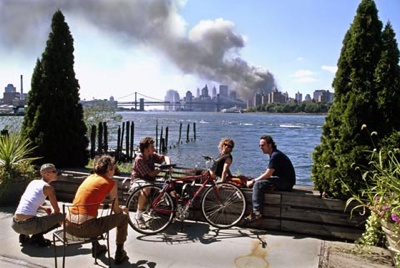There has been a lot of discussion about a photograph by Thomas Hoepker taken after the collapse of the Twin Towers on 9/11. The picture below is from a book called Watching the World Change: The Stories Behind the Images of 9/11 by David Friend. I haven’t seen the book yet, so I will only address the Hoepker picture, which has been widely disseminated. Hoepker, apparently aware that his photograph might generate misunderstandings, waited more than four years before publishing it.

Photo by Thomas Hoepker
Frank Rich wrote in his weekly New York Times column:
Seen from the perspective of 9/11’s fifth anniversary, Mr. Hoepker’s photo is prescient as well as important—a snapshot of history soon to come. What he caught was this: Traumatic as the attack on America was, 9/11 would recede quickly for many. This is a country that likes to move on, and fast. The young people in Mr. Hoepker’s photo aren’t necessarily callous. They’re just American. In the five years since the attacks, the ability of Americans to dust themselves off and keep going explains both what’s gone right and what’s gone wrong on our path to the divided and dispirited state the nation finds itself in today.
Many have taken issue with Rich’s assertion that the photograph illustrates America quickly moving on. Two of the people shown in the photograph have come forward to say that contrary to their casual appearance they were deeply shocked by what was going on. One of them criticized Hoepker for making a picture so open to misinterpretation in advancement of his own career.
The other said:
I am also a professional photographer and did not touch a camera that day. Why? For many reasons including a now-obvious one: This somewhat cynical expression of an assumed reality printed in the New York Times proves a good reason. (Shame on Mr. Rich and Mr. Hoepker—one should never assume.) But most of all to keep both hands free, just in case there was actually something I could do to alter this day or affect a life, to experience every nanosecond in every molecule of my body, rather than place a lens between myself and the moment. (Sounds pretty “callous,” huh?) I also have a strict policy of never taking a photograph of a person without their permission or knowledge of my intent.
As a photographer who usually deals with “real” situations, I am always aware of the “fiction” of the image. This dichotomy of the real and the fictional is what photography is about–what makes it powerful–and what makes it disturbing.
Moreover, the experience of an event does not necessarily unfold visually like Hollywood movies with heightened action and dramatized points of view. There are an infinite number of perspectives in time and space of an event. Many photographers seek to control meaning by creating images that confirm certain cultural habits of seeing and framing the world. I prefer to work against that way of seeing, though I know I can never truly escape it. Viewers of photographs bring those same cultural references to bear, often uncritically.
Photography is by definition a predatory act. One is always stealing, appropriating, and intruding. I have, or so I feel, a careful sense of ethical responsibility, but in the end I know that the images I take are not in themselves “humane” or “compassionate.” They are what they are, take ’em or leave ’em.
With regard to the Hoepker image, it’s interesting to have the photographer and two of the people depicted weigh in, but ultimately, the picture provides a simple narrative: that most of us witnessed the horror of this event from afar, passively–like it or not–in the uniform of the moment–appropriate or not–on a beautiful summer day. For me, that distance, with its aura of disengagement, makes the image all the more poignant and lasting.
BAGnewsNotes
Blog discussion of news images
David Friend
Website for the book